The Medial Gluteal muscle
We are no longer building saddle trees, but we have two videos about how Western saddles fit horses available on our westernsaddlefit.com website.
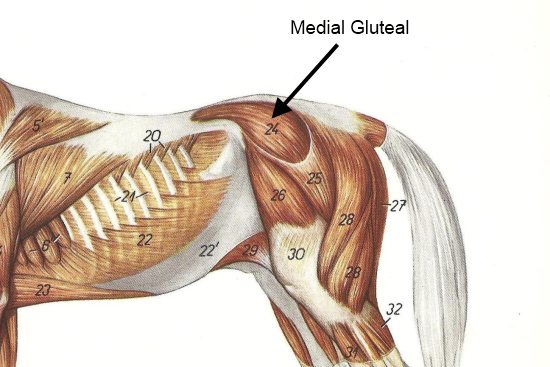
Well, I'm finally getting around to that hind end muscle I promised I'd write about before my interlude post. The name of this muscle - the Medial Gluteal. This is a massive muscle. It makes up a large proportion of the top of the horse's rump, and when you realize how it attaches and what it does, you understand why it has to be so large. Note: The word medial comes from the Latin, where it means middle, so this muscle is also often call the Middle Gluteal muscle. But medial sounds more anatomy-ish, so that's what I used.
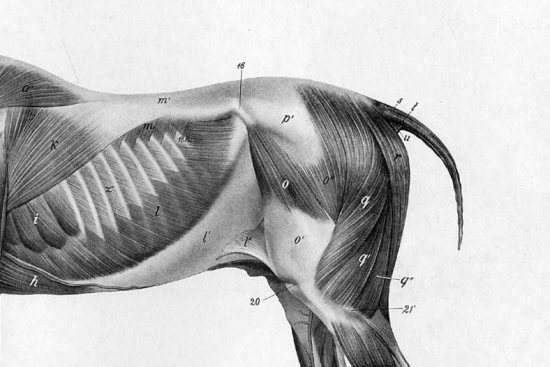
The medial gluteal is not directly underneath the skin, though it is close in places. Its cranial (toward the head) end is covered by the thoracolumbar (m' in the above picture) and the gluteal (p') fascia. (Fascia is that very strong, glistening white tissue you cut off your steak. It acts as the insertion point for a lot of muscles.) Its caudal (toward the tail) end is covered by superficial gluteal (o'') and the biceps femoris (q) muscles.
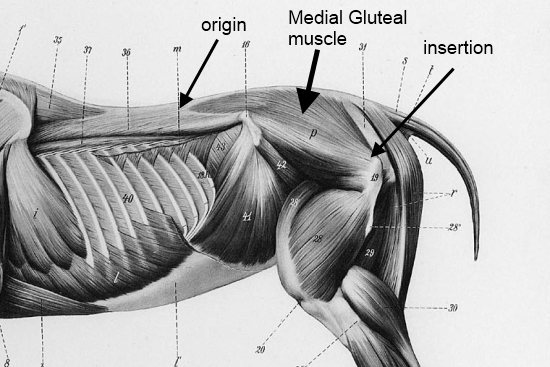
When you get those removed, you can see the extent of the horse that is covered by the medial gluteal muscle (p in the picture above). It starts out small and flat, and its origin (the attachment closest to the body) can be as far ahead as L1. It originates on the aponeurosis (large, flat tendon) of the lumbar part of the longissimus muscle which lies underneath it.
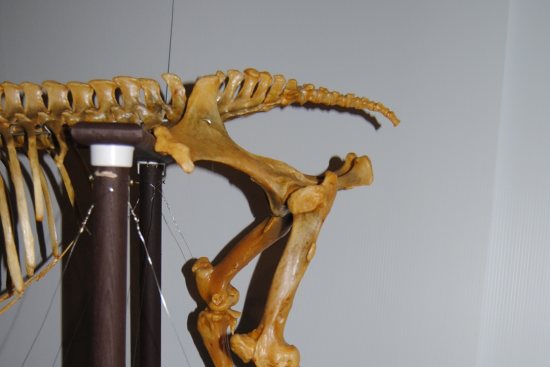
As it goes back, it quickly gets larger and is firmly attached to the large flat area on the lateral (away from the midline) side of the pelvis and the ligaments that run between the different parts of the pelvis which lie above it. So while the medial gluteal attaches to the top of the back, it is also firmly attached to the pelvis.
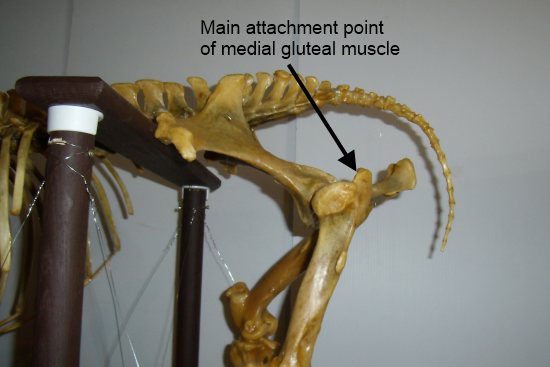
It inserts on the top of the femur. Now you might think that anything running from the pelvis to the femur would pull the thigh forward and flex the hip joint. But look! There is another one of those famous stickie-outie-thingies (official name being the greater trochanter of the femur) that are places for tendons to attach. It extends up from the top of the femur above the hip joint, and that is where most of the medial gluteal attaches. (There are smaller pieces of the muscle which attach close, but not exactly to, the top of the greater trochanter.)
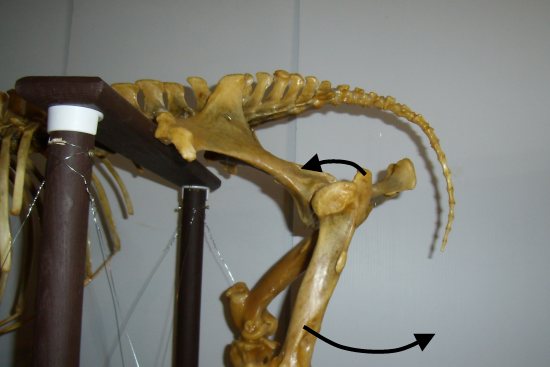
So you can see that if the medial gluteal pulls forward on the greater trochanter, it goes forward. But because it is above the level of the hip, the rest of the femur is pulled backward. And if you remember anything about levers from physics class, you can understand how moving that small section close to the fulcrum (hip joint) a short distance will move the much longer section of the femur through a much larger arc in the opposite direction. But it takes a lot of power to move a large section by pulling on a small section - which explains why the medial gluteal muscle is so large, and so well anchored.
What does it do?
So the medial gluteal is actually a major extender of the hip. What does this mean? Well, when there is weight on the leg, the medial gluteal is a primary muscle in moving the body forward over the hind leg. When there is no weight on the leg, the medial gluteal gives a lot of power to a backwards kick. And because of the way it attaches to the pelvis and lumbar region of the back, it is also very active when the horse rears. (Note: the other pieces that attach elsewhere also help to abduct the hind leg - move it away from the midline.)
How does the saddle affect it?
Since most of it is over the horse's rump, why are we talking about it in terms of saddle fit? Because of that cranial most attachment. Remember that the very first bit can start as far forward as L1, and that all western saddles extend onto the loin of the horse. While I will continue to repeat that weight (pressure) on the loin is perfectly OK, I will also continue to repeat that excess pressure - such as when the back bar tips Poke into the loin due to too little rock or not enough relief built into them for the shape of the horse's back they are on - is damaging. And what is getting Poked is the aponeurosis and fascia that make up the origin of the medial gluteal. When this happens, the horse won't use that muscle to its full extent, affecting the power of the hind end.
It can also affect how far the horse is willing to extend his leg both forward and back. If anyone has had tennis elbow (like I have) you know that when you flex your elbow tightly, it really hurts because the muscle is pulling hard on the tendon that is sore. But if you straighten your arm to the max, it also hurts. While the tendon isn't being pulled on due to muscle contraction, it is being pulled on because the muscle is being stretched out to its maximum by the antagonistic muscles pulling the opposite direction. In the same way, pain at the origin of the medial gluteal due to the muscle pulling on the originating tissues means the horse won't stretch his leg out as far behind. But he also doesn't stride under himself as far as he normally would either due to pain caused by the medial gluteal being stretched out and therefore pulling on the originating tissues.
Overall...
the horse loses power in his hind end, won't stride out as much if he is really having to move and won't collect up and move his hind legs under his body as far as normal. So while the horse is fine carrying weight that far back, Poking with the back bar tip is a bad thing!
The medial gluteal is the only hind end muscle I am going to cover. Next up - the major muscle of the back - the longissimus dorsi.
